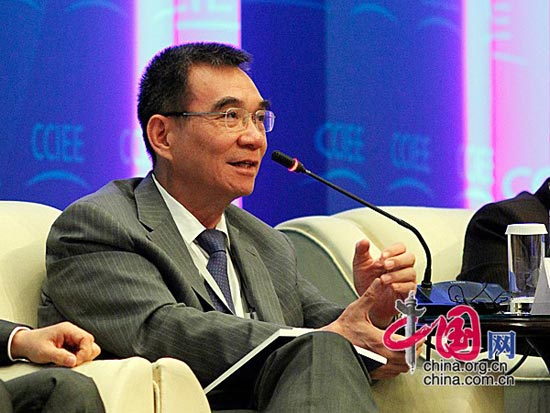Advantage of being a latecomer
- By Justin Yifu Lin
 0 Comment(s)
0 Comment(s) Print
Print E-mail China Daily, August 7, 2013
E-mail China Daily, August 7, 2013
China needs to promote continuous technological innovation and industrial upgrading to further tap growth potential
After three decades of 9.8 percent average annual GDP growth, the Chinese mainland's economic expansion has been slowing for 13 consecutive quarters - the first extended period of deceleration since reform and opening-up was launched in 1979. Real GDP grew at an annual rate of only 7.5 percent in the second quarter of this year, though it is equal to the target set by the Chinese government at the beginning of this year. Many indicators point to further economic deceleration, and there is a growing bearishness among investors about the outlook for the mainland economy, and many are wondering if China will crash.
|
|
|
Justin Yifu Lin, former chief economist at the World Bank [Photo/China.org.cn] |
In fact, many other rapidly growing emerging economies have suffered - and worse than China - from the drop in global demand resulting from the ongoing retrenchment in high-income economies since the 2008 financial crisis. For example, GDP growth in Brazil has slowed sharply, from 7.5 percent in 2010 to 2.7 percent in 2011 and to just 0.9 percent in 2012, while India's growth rate slowed from 10.5 percent to 3.2 percent over the same period.
Moreover, many high-income newly industrialized economies with few structural problems were not spared the effects of the 2008 crisis. South Korea's GDP growth, for example, slowed from 6.3 percent in 2010 to 3.7 percent in 2011 and to 2 percent in 2012.
Given this, China's economic slowdown since the first quarter of 2010 has mainly been caused by external and cyclical factors. Facing an external shock, the Chinese government should and can maintain a 7.5 percent growth rate by taking counter-cyclical and proactive fiscal-policy measures, while maintaining a prudent monetary policy. After all, China has high private and public savings, foreign reserves exceeding $3.3 trillion, and great potential for industrial upgrading and infrastructure improvement.
Indeed, China can maintain an 8 percent annual GDP growth rate for many years to come, because modern economic growth is a process of continuous technological innovation and industrial upgrading. Of course, this is true for developed and developing countries alike. But developed countries differ from developing countries in an important way. Since the Industrial Revolution, developed countries have always been on the global frontier of technologies and industries, which has required them to invest in costly and risky indigenous research and development.
By contrast, technologies and existing industries in developing countries are in general well within the global frontier. As a result, they benefit from the "latecomer's advantage", in which technological innovation and industrial upgrading can be achieved by imitation, import, and/or integration of existing technologies and industries, all of which implies much lower R&D costs.
In theory, any developing country that can harness its latecomer's advantage to achieve technological and industrial upgrading can grow faster than developed countries. According to the Commission on Growth and Development led by Nobel laureate Michael Spence, 13 economies took full advantage of their latecomer status after World War II and achieved annual GDP growth rates of 7 percent or higher at least twice as high as developed countries' growth rates for 25 years or longer.
The Chinese mainland became one of the 13 economies after 1979. Because its latecomer status explains its 33 years of rapid economic growth, the key to understanding its potential for further rapid growth in the future lies in estimating how large those advantages still are.
Per capita GDP, which reflects a country's average labor productivity and its overall technological and industrial achievement, is a useful proxy to estimate the advantage of being a latecomer. That is, the per capita GDP gap between China and developed countries essentially reflects the gap between them in terms of overall technological and industrial achievement.
According to the most up-to-date estimate by the economic historian Angus Maddison, the Chinese mainland's per capita GDP in 2008 was $6,725 in 1990 dollars, which was 21 percent of per capita GDP in the United States. That is roughly the same gap that existed between the economies of the US and Japan in 1951, the US and Singapore in 1967, the US and Taiwan in 1975, and the US and South Korea in 1977. Harnessing their advantages as latecomers, Japan's average annual growth rate soared to 9.2 percent over the next 20 years, Singapore's to 8.6 percent, Taiwan's to 8.3 percent and South Korea's to 7.6 percent.
If the latecomer's advantage implied by the income gap between the four newly industrialized economies and the US enabled the four economies to realize average annual GDP growth rates of 7.6 percent to 9.2 percent for 20 years, the Chinese mainland's annual growth potential should be a similar 8 percent from 2008 to 2028.
But to fully realize its potential growth as a latecomer, China needs, above all, to deepen its market-oriented reforms, address various structural problems, and develop its economy according to its comparative advantages.
The author, a former chief economist and senior vice-president at the World Bank, is professor and honorary dean of the National School of Development, Peking University, and the founding director of the China Center for Economic Research.
Project Syndicate







Go to Forum >>0 Comment(s)